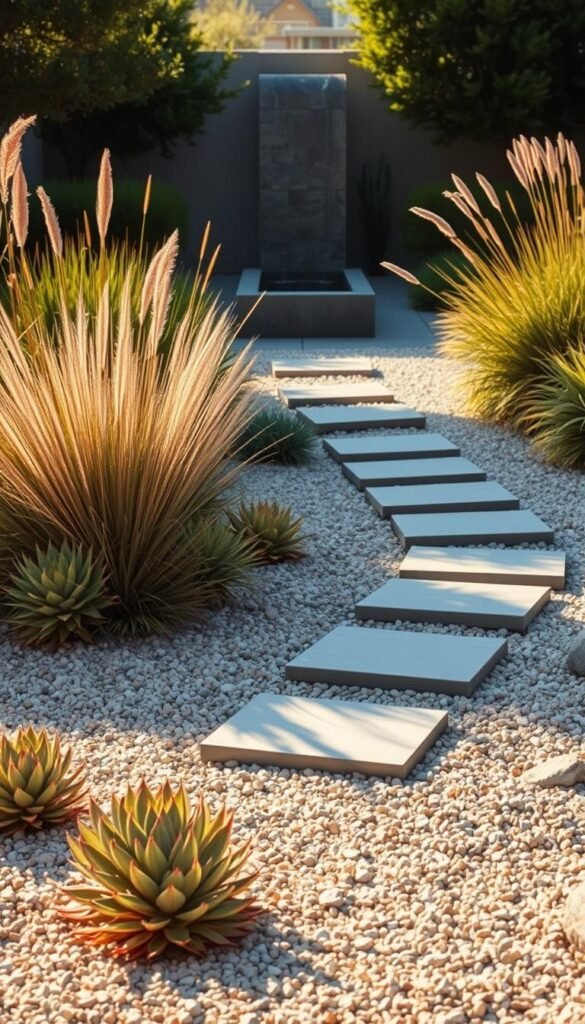Dreaming of a beautiful yard that practically takes care of itself? Drought-resistant landscaping offers the perfect solution for busy homeowners. By blending natural textures with strategic design, you can craft an inviting environment that thrives with little attention.
This approach uses free-draining materials like crushed stone paired with hardy perennials. Mediterranean favorites such as lavender and ornamental grasses flourish in these conditions, while the gravel layer naturally prevents weeds. You’ll spend less time watering and more time enjoying your effortless oasis.
For urban dwellers or those with packed schedules, incorporating low-maintenance plants ensures year-round interest without constant care. The right combinations create movement and color through seasons, from spiky eryngiums to soft feather grasses.
Best of all? These designs adapt to any climate. Whether you’re working with a sunny backyard or a cozy patio, smart material choices and plant placement deliver lasting beauty. Your outdoor area becomes a living masterpiece that evolves gracefully – no green thumb required.
Introducing Your Modern Gravel Garden
Transform your outdoor area into a chic, hassle-free retreat that adapts to your lifestyle. Crushed stone isn’t just practical—it’s a blank canvas for crafting spaces that feel both polished and organic. Whether you prefer crisp geometric layouts or flowing natural arrangements, this approach lets you blend form and function effortlessly.
Why Gravel Landscaping Works
Homeowners love gravel for its flexibility. It solves common problems like poor soil or tricky slopes while adding instant texture. Unlike thirsty lawns, these setups need minimal watering and suppress weeds naturally. You get a tidy look year-round without endless upkeep.
Redefining Your Space
Modern design turns ordinary yards into curated environments. Think angular pathways framed by drought-resistant shrubs or circular seating areas surrounded by silvery stones. Even narrow side yards become striking features when layered with contrasting pebble sizes.
Your choices matter—warm terracotta gravel complements Mediterranean homes, while cool gray tones suit contemporary architecture. Mix in sculptural plants like yucca or lavender for pops of color that thrive with little attention. Suddenly, that forgotten corner becomes your favorite spot.
Benefits of Choosing a Gravel Garden
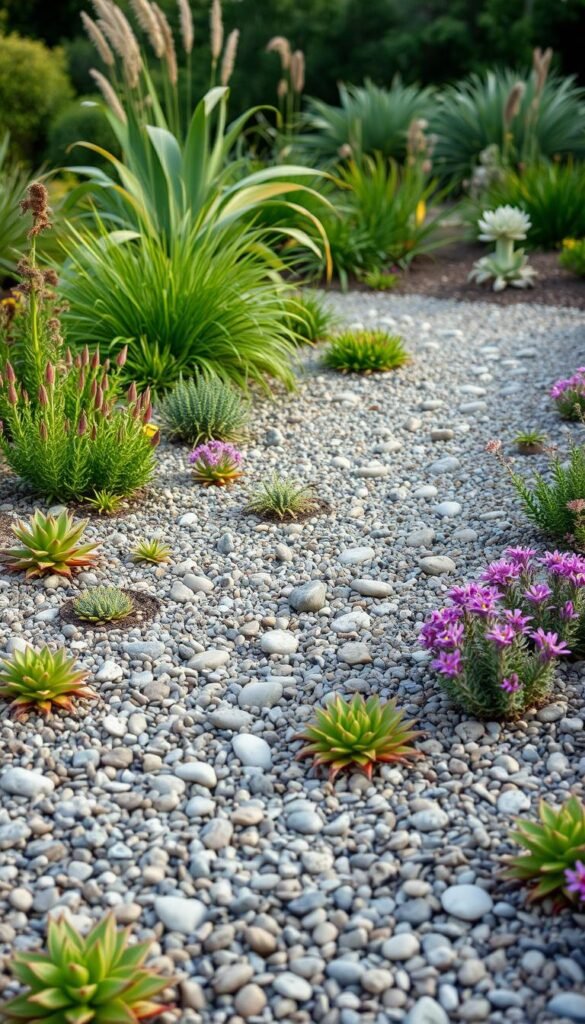
What if your backyard could look sharp while saving you effort and resources? This landscaping approach delivers beauty through smart material choices and plant partnerships. Let’s explore how these spaces become self-sufficient showstoppers.
Effortless Care Meets Water Wisdom
Maintenance becomes a breeze with gravel’s natural weed-blocking power. No more weekend battles with stubborn growth or muddy shoes after rain. The stone layer locks in soil moisture, meaning less watering for your drought-loving plants.
Thriving Through Dry Spells
These gardens laugh at water restrictions. Hardy perennials like sedum and sage shrug off summer heat while gravel prevents root rot through perfect drainage. You’re not just saving time – you’re creating a microclimate where plants prosper naturally.
Bonus perks? Lower utility bills and no chemical runoff. Your space stays vibrant during droughts that leave lawns brown. It’s landscaping that works smarter, not harder.
12 Gravel Garden Ideas for a Modern, Low-Maintenance Landscape
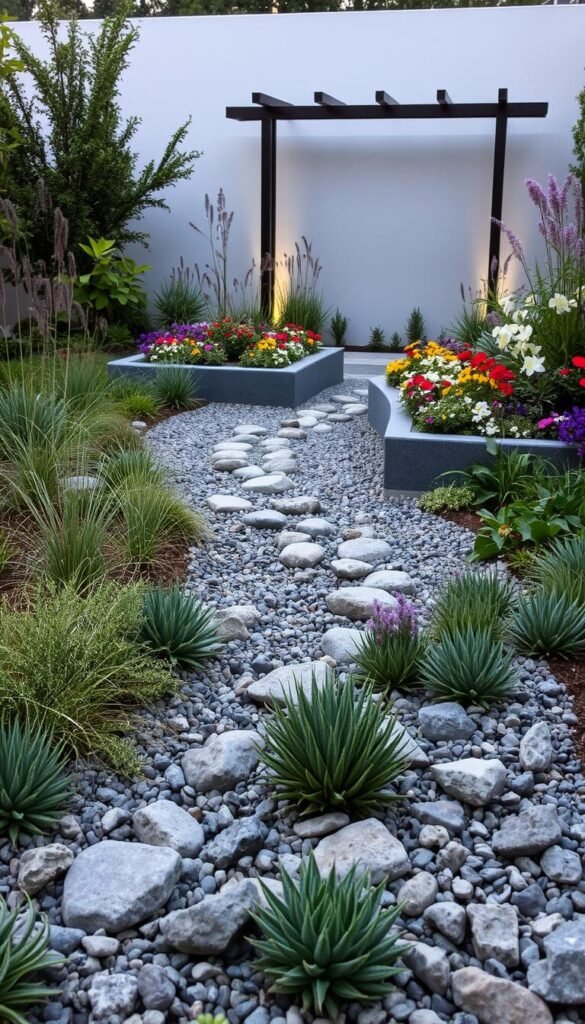
Ready to reimagine your outdoor space? Discover fresh garden ideas that blend structure with natural charm. By mixing textures and embracing open layouts, you can craft a dynamic environment that feels intentional yet relaxed.
Exploring Creative Design Inspiration
Think beyond basic stone coverage. Pair feathery grasses with chunky gravel for contrast, or use rounded pebbles to soften angular pavers. A loose arrangement of drought-tolerant perennials gives your space an organic look that evolves naturally over time.
Consider these adaptable concepts:
| Style | Key Features | Plant Pairings |
|---|---|---|
| Modern Minimalist | Clean lines, monochromatic stones | Spiky yucca, silver mound artemisia |
| Rustic Charm | Curved pathways, mixed gravel sizes | Lavender, creeping thyme |
| Urban Oasis | Geometric planters, seating nooks | Ornamental grasses, sedum varieties |
Front yards shine when you replace thirsty lawns with a gravel garden featuring sculptural agaves. Add a small pond surrounded by smooth river rocks to attract dragonflies and birds. For cozy evenings, create conversation areas with built-in benches and clusters of aromatic herbs.
These ideas prove that less can be more. By focusing on strategic placements rather than dense plantings, you maintain visual interest without overwhelming the space. The variety of approaches ensures there’s a perfect match for every home’s personality and your maintenance preferences.
Designing a Contemporary Layout
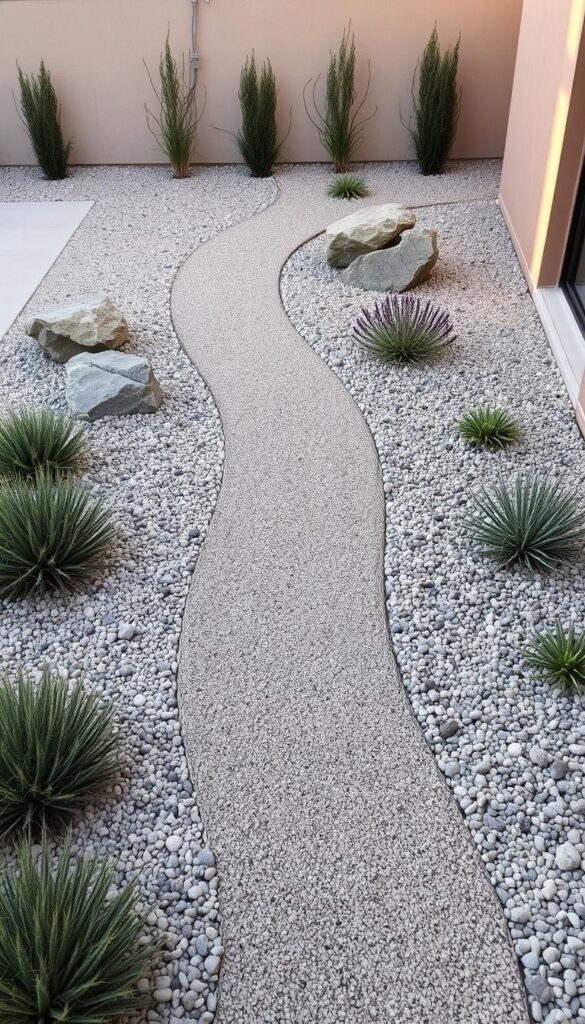
Crafting a stylish outdoor retreat starts with smart spatial organization. Break your landscape into purposeful areas using visual cues like contrasting stone textures or meandering paths. This approach transforms open spaces into engaging environments that feel both intentional and inviting.
Planning Zones and Distinct Garden Areas
Begin by mapping out functional zones for lounging, dining, or plant displays. Use crushed limestone around seating spots and pea gravel for walkways to naturally separate spaces. Larger stones make excellent informal borders, while color variations guide movement through your design.
Consider these strategies for cohesive flow:
- Position sun-loving succulents in bright zones and shade-tolerant ferns in sheltered areas
- Create depth by pairing low-growing thyme carpets with vertical grasses
- Use charcoal-gray gravel to frame geometric planting beds
Elevation changes add drama without complexity. A slight mound with cascading sedums becomes a focal point, while recessed paths lined with smooth pebbles draw the eye forward. Always balance practical needs – like drainage patterns and foot traffic – with your modern aesthetic.
Negative space plays a starring role in contemporary layouts. Leave breathing room between features to highlight clean lines and architectural plants. Your space becomes a curated collection of moments rather than a crowded collection of elements.
Creative Planting Techniques and Ground Cover Options
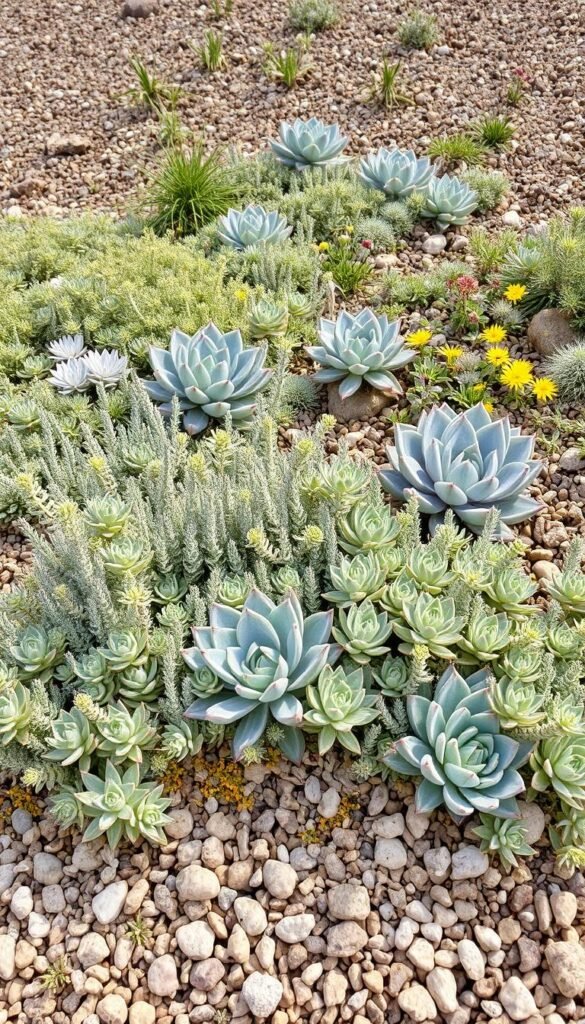
Bring your landscape to life with plants that work smarter, not harder. Strategic choices create vibrant displays while respecting your time and local climate. Let’s explore how texture and resilience combine for striking results.
Selecting Mediterranean and Drought-Tolerant Plants
Sun-loving varieties like lavender and cistus thrive where others struggle. Their silvery foliage reflects heat, while deep roots tap into moisture below gravel layers. Pair spiky eryngiums with rounded phlomis shrubs for contrast that pops against stone backdrops.
These champions need just three things: full sun, sharp drainage, and occasional trimming. Bulbs like alliums add spring surprises, while evergreen rosemary provides year-round structure. You get color without constant watering.
Utilizing Ornamental Grasses and Thyme for Texture
Feathery miscanthus or blue fescue soften stone surfaces with graceful movement. Plant them in drifts where breezes can animate their blades. Between pavers, creeping thyme forms fragrant cushions that release scent when brushed.
Low-growing options solve multiple challenges. Corsican mint fills shady gaps with emerald carpets, while sedums spread across sunny slopes. These living mosaics prevent erosion and outcompete weeds naturally.
Vary heights and leaf shapes for four-season drama. Tall grasses catch winter frost, while thyme stays evergreen in mild climates. Your space becomes a tapestry that changes with the light and weather.
Enhancing Your Space with Seating Areas and Water Features
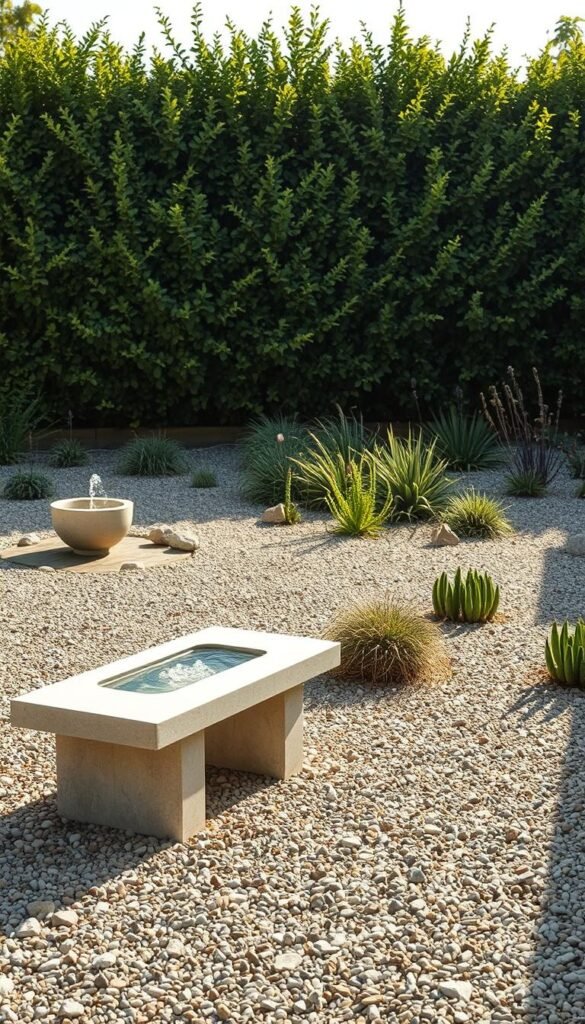
Turn your outdoor retreat into a multi-sensory escape through thoughtful placement of relaxation zones and liquid accents. These elements work together to create rhythm and purpose in your design while boosting enjoyment.
Crafting Comfort Zones
Position your seating area where paths naturally converge, using crushed stone textures to signal transition. Flank benches with airy grasses that sway in the breeze, offering privacy without blocking views. Consider sun patterns – morning coffee spots might face east, while evening lounging areas benefit from western sunset vistas.
These arrangements feel intentional yet relaxed. A curved stone bench nestled between lavender bushes creates an intimate nook. For larger spaces, try a central fire pit surrounded by low chairs and drought-tolerant succulents.
Liquid Harmony in Stone
Water features bring movement and wildlife to your sanctuary. A recirculating fountain requires minimal upkeep while masking street noise. For natural appeal, build a pebble-lined pond with marginal plants like irises that thrive in moist conditions.
| Feature Type | Benefits | Maintenance Level |
|---|---|---|
| Birdbath | Attracts songbirds | Weekly cleaning |
| Bubbling Rock | Soothing sounds | Seasonal pump check |
| Reflecting Pool | Doubles plant visuals | Leaf skimming |
Pathways leading to water elements gain purpose. Use larger stepping stones through finer gravel to guide feet toward relaxation spots. The crunch underfoot becomes part of the experience – a tactile reminder you’re entering your personal oasis.
These additions transform static layouts into living environments. Dragonflies dart over ponds while rustling grasses frame your favorite reading chair. You’ve created not just a landscape, but a destination.
Incorporating Potted Plants and Container Displays
Elevate your landscape design by blending movable greenery with permanent stone features. Containers introduce dynamic vertical elements that contrast beautifully with flat gravel surfaces. Their portability lets you refresh layouts with seasonal blooms or architectural specimens.
Using Pots as Focal Points
Strategically position oversized planters where sightlines converge. A cobalt-blue urn overflowing with golden oregano becomes an instant centerpiece. For modern spaces, cluster geometric concrete pots planted with spiky dracaena at varying heights.
These displays solve multiple design challenges:
| Container Type | Benefits | Top Plant Picks |
|---|---|---|
| Tall Ceramic | Adds height, shelters delicate plants | Japanese maple, cordyline |
| Shallow Bowls | Showcases succulents, herbs | Sedum varieties, creeping thyme |
| Hanging Baskets | Utilizes vertical space | Fuchsia, trailing lantana |
Rotate flowering annuals like petunias in spring and chrysanthemums in fall. The stone base keeps containers stable while highlighting their colors. Acid-loving camellias thrive in pots when your native soil leans alkaline.
Group three matching vessels along pathways to guide movement. Place fragrant jasmine near seating areas where breezes carry its scent. Your space gains depth through layered textures and strategic pops of color.
Maintenance Strategies for Your Gravel Garden
What if your garden needed just minutes of care each month? With smart planning, you can enjoy a polished landscape that stays vibrant with minimal effort. The secret lies in leveraging gravel’s natural benefits while addressing common challenges proactively.
Smart Weed Control Solutions
Weeds rarely stand a chance against well-prepared gravel layers. Start by removing existing growth and laying landscape fabric in problem areas. This barrier blocks unwanted plants while letting water reach your drought-tolerant favorites. For a more natural look, allow self-seeding thyme or sedum to fill gaps – they’ll crowd out invaders naturally.
Three maintenance wins with gravel:
- Rake surfaces seasonally to prevent organic debris buildup
- Spot-treat persistent weeds with vinegar solutions instead of chemicals
- Top up gravel depth every 2-3 years to maintain weed suppression
Mastering Moisture Management
Your gravel garden thrives when water moves freely. While the stone layer naturally improves drainage, watch for pooling near plant bases. Create subtle slopes during installation – just 1-2% grade keeps roots happy. In heavy clay soil, mix in sand before laying gravel to boost permeability.
| Issue | Quick Fix | Long-Term Solution |
|---|---|---|
| Waterlogged areas | Add French drain | Regrade surface |
| Dry patches | Hand-water target zones | Install drip irrigation |
Remember: gravel acts as nature’s mulch. It maintains consistent soil temperatures year-round, protecting roots from sudden freezes or heat waves. Your plants stay healthier, needing less babying through seasonal changes.
Sourcing Materials an
Building your ideal outdoor space starts with quality materials. Visit local stone yards to compare gravel textures – from crushed granite’s crisp edges to river rock’s smooth appeal. Many suppliers offer sample bags to test colors in your specific light conditions.
Coordinate your stone choices with existing hardscapes. Warm terracotta tones complement brick patios, while cool grays pair with concrete. For eco-friendly options, ask about recycled glass aggregates that sparkle in sunlight.
Don’t overlook plant sourcing. Nurseries specializing in drought-tolerant species ensure healthier starts. Look for compact varieties of lavender or ornamental grasses bred for your climate zone. Some growers even deliver pre-planted containers for instant impact.
Finish with purposeful accents. Solar path lights add evening charm without wiring. A weathered bench or sculptural birdbath personalizes the space. Check community recycling centers for discounted pavers or unique finds.
Your local extension office often lists trusted vendors and seasonal sales. With the right resources, you’ll create a cohesive look that feels intentional yet effortless – ready for years of relaxed enjoyment.

